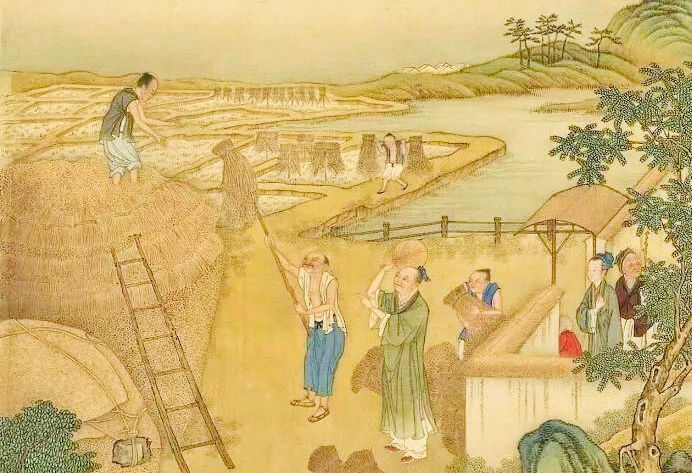The Epic of China’s Agrarian Civilization — A Brief Analysis of The Classic of Poetry · The Seventh Month, Stanza 7
- Hongji Wang
- 3 days ago
- 3 min read
Stanza 7:
In the ninth month, they build threshing yards and gardens;
九月築場圃,
In the tenth, they store the grain.
十月納禾稼。
Millet and glutinous millet, late grain and early grain;
黍稷重穋,
rice, hemp, beans, and wheat—Alas, my farmers!
禾麻菽麥,嗟我農夫。
Our harvest is done, now we must go to repair the granaries.
我稼既同,上入執宮功。
By day you thatch with straw, by night you twist ropes;
晝爾於茅,宵爾索綯。
Swiftly you mend the lofty roofs, so to begin souring the hundred grains.
亟其乘屋,其始播百穀。

The phrase “場圃 (chǎng pǔ)” refers to a hard-packed threshing ground, typically the size of a vegetable garden, used for treading and threshing grain stalks. “禾 (hé)” has multiple meanings: it can broadly stand for all grains, or specifically refer to sorghum. In oracle bone script, the character depicts the shape of ripened sorghum.

“黍 (shǔ)” is foxtail millet (often appearing as yellow millet), and “稷 (jì)” is broomcorn millet. “重穋 (chóng lù)” is explained in Mao Shi Zhengyi (《毛詩正義》) as
“late-ripening is 重 (chóng), early-ripening is 穋 (lù).”
This explanation is apt. “重” is cognate with “種 (zhǒng)”, “crop that can ripen twice a year,” while "穋" refers to early-sown, early-ripening varieties.

“同 (tóng)” here means “gathered together.” “上入 (shàng rù)” means “to go up and enter” the government facility, that is, to perform compulsory corvée. “執宮功 (zhí gōng gōng)” means “to undertake palace duties,” specifically repairing or constructing public buildings.
“茅 (máo)” refers to thatch grass used for roofing. “索 (suǒ)” means “to twist,” and “綯 (táo)” refers to rope made by twisting fibers. “亟 (jí)” means “to do urgently or quickly.” Its oracle-bone form depicts a person standing with head touching the sky and feet on the ground, signifying extremity and thus “to complete with utmost effort.”

“乘 (chéng)” originally shows a person climbing a tree and later came to mean “lofty or elevated.” “其 (qí)” conveys “only then can it be so.” “棄 (qì)” is the name of the Zhou ancestor, later honored as “後稷 (hòu jì).” “後 (hòu)” here carries the meaning of “to govern or oversee.” “稷 (jì)” refers to broomcorn millet. “播百穀 (bō bǎi gǔ),” meaning “sowing the hundred grains,” originates from the The Book of Documents — The Canon of Shun (《尚書・舜典》), in which the ancestor Hou Ji is praised:
“Qi, when the people suffered hunger, you, Hou Ji, sowed the hundred grains in their seasons.”
The Book of Songs adopts the same expression.

This chapter describes in detail the agricultural work of autumn harvest and winter storage. A complete paraphrase is as follows: by the ninth month, the threshing ground is prepared. In the tenth month, various crops are brought in—millet, broomcorn millet, early and late varieties of grain, sorghum, hemp, beans, and wheat. The verse laments the hardships of the farmers: after gathering all the harvest, they must still perform corvée labor for the state—cutting thatch during the day for roofing, twisting ropes at night for construction. They hurry to complete the tall structures needed to store the grain, so that preparation may be made for next spring’s sowing of the hundred grains.
To be continued.
_edited.png)



Comments